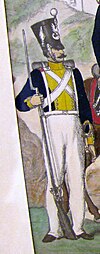

The 4th Line Infantry Regiment (Polish: 4. pułk piechoty liniowej) was a regiment of the Kingdom of Poland. Formed in 1815, the regiment distinguished itself in the battles of the November Uprising and remains one of the best-known units of the Polish Army of the era. The soldiers of the regiment are known in Polish historical works as the Czwartacy.
History
The regiment was directly descended from the Napoleonic Duchy of Warsaw's 4th Infantry Regiment [pl]. After Napoleon lost control of Poland in 1812, the regiment remained loyal to the emperor and fought in battles of Leipzig and Arcis-sur-Aube. After his abdication and exile to the Island of Elba, the remnants of the regiment returned to Russian-controlled Kingdom of Poland with their regimental flags, swore an oath to the Russian Tsar and became the cadre of a newly-formed infantry regiment with the same number. Their old regimental flag was retired and is preserved in the Warsaw-based Polish Army Museum.
Like its predecessor, the new regiment was based in Warsaw and its main barracks were in the Sapieha Palace. The regiment was recruited in and around Warsaw from a broad cross-section of society including noblemen (szlachta), burghers, and many serfs and peasants.
Because of the proximity of the barracks to the Grand Duke Konstantin Pavlovich's palace, the 4th Regiment became one of his favourite military units and its soldiers enjoyed the status of his personal guard. This meant that the Grand Duke, very fond of his military units, while also cruel and brutal in their treatment, would march the regiment's soldiers days and nights, in every weather. The maltreated regiment's morale was low, yet any sign of discontent was brutally repressed: among those punished was the regiment's Major, a freemason, Walerian Łukasiński. Denounced as the founder of a secret society, he was sentenced to seven years of imprisonment, but eventually was held without trial for 46 years in Russian prisons, most of that in solitary confinement.
November Uprising
Following the outbreak of the November Uprising, the regiment rebelled against the Russian Tsar together with most of the army of the Kingdom of Poland. It fought from the very first day of the uprising and distinguished itself in the First and Second Battle of Wawer, as well as the battles of Dębe Wielkie, Ostrołęka and the final Battle of Warsaw.
Nicknames
Officially named the "4th Line Infantry Regiment", the soldiers of the new unit continued to use the nickname of Czwartacy ("Men of the Fourth"), which had achieved some notoriety.
During the uprising the unit also was often referred to as "Tysiąc Walecznych" ("A Thousand Brave Men") both by the press and general populace. This nickname was popularised in Europe by a German poet Julius Mosen, who published in 1832 a popular poem idealising the regiment and its actions during the war of 1830-1831.
Decorations
During the November Uprising, the regiment received 214 Virtuti Militari crosses: five 3rd class, 55 fourth class and 154 fifth class. This made it one of the most highly decorated Polish units of the epoch.
Regimental commanding officers
- Ignacy Mycielski
- Col. Ludwik Bogusławski (1818 - 1820)
- Lt.Col. Wit Czajkowski, (1818, again from 18 March 1831)
- Lt.Col. Stanisław Kindler (from 17 April 1831)
- Lt.Col. Klemens Jórski (from 22 April 1831)
- Lt.Col. Kazimierz Majewski (from 20 June 1831)
- Lt.Col. Józef Borzęcki (from 22 September 1831)
- Józef Święcicki
References
Citations
- ^ Gembarzewski, p. 69
- The matter is discussed in: Kostołowski, pp. 12-25 and onwards
- ^ Nadolski, p. 102
- Krzemicka, pp. 162-163
- Domański (ed.), p. 1
Bibliography
- Bronisław Gembarzewski (1925). Rodowody pułków polskich i oddziałów równorzędnych od r. 1717 do r. 1831 [The lineage of Polish regiments and regiment-sized units from 1717 til 1831]. Biblioteka Muzeum Wojska (in Polish). Warsaw: Towarzystwo Wiedzy Wojskowej.
- Erazm Kostołowski (1938). Chłopi-czwartacy: z dziejów pułku 4 piechoty liniowej 1815-1831 [Peasant-Czwartacy: the history of the 4th Regiment of Line Infantry, 1815-1831]. Wieś i Państwo (in Polish). Vol. 10. Lwów: Wieś.
- Zofia Krzemicka (1930). Ludwik Finkel (ed.). Powstanie listopadowe 1830-1831 [November Uprising 1830-1831]. Biblioteka Macierzy Polskiej (in Polish). Lwów: Macierz Polska.
- Artur III Nadolski (2008). Pani Chłodna: opowieść o warszawskiej ulicy [Madame Chłodna: Story of a Street in Warsaw] (in Polish). Warsaw: Bellona. ISBN 9788311112582.
- Waldemar Domański, ed. (2011). "Pułk Czwarty" [4th Regiment]. Biblioteka Polskiej Piosenki (in Polish). Kraków: Ośrodek Kultury Biblioteka Polskiej Piosenki. Retrieved 2013-10-18.